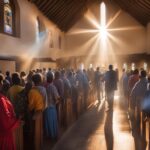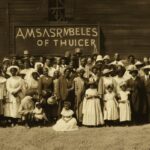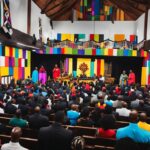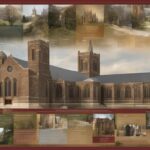Starting a church involves more than just having a statement of belief and a website. It requires key growth strategies based on Biblical principles. This includes starting a small discussion group, turning that group into a launch team, legally establishing the church, considering affiliation with a network or denomination, and growing through excellence in love. There will always be excuses for not starting a church, but if you feel called to do so and believe your community is missing something, it may be time to start your own church.
Key Takeaways:
- Starting a church involves strategic planning based on biblical principles.
- A small discussion group can be the foundation for launching a church.
- Legally establishing the church is an important step in the process.
- Consider affiliation with a network or denomination for support and guidance.
- Growing your church is a continuous journey fueled by love and a strong sense of purpose.
History and Origins of the Church
The history and origins of the church are deeply rooted in ancient times. Throughout centuries, the church has evolved and transformed, shaped by historical events and societal changes. One significant event that influenced the course of church history is the separation of church and state, which established the principle of religious freedom and autonomy.
Religious institutions have played a vital role in preserving the history and traditions of the church. These institutions serve as pillars of faith, passing down teachings and practices from generation to generation. They provide a place of worship, guidance, and community support for believers.
“The church history is a testament to the enduring nature of faith and spirituality. It has withstood challenges, adapted to new circumstances, and continued to be a source of hope and inspiration for millions of people.”
Throughout its journey, the church has witnessed remarkable achievements, faced oncoming challenges, and overcome obstacles through strength, perseverance, and unity. The rich tapestry of the church history serves as a reminder of the power of faith and the resilience of religious institutions.
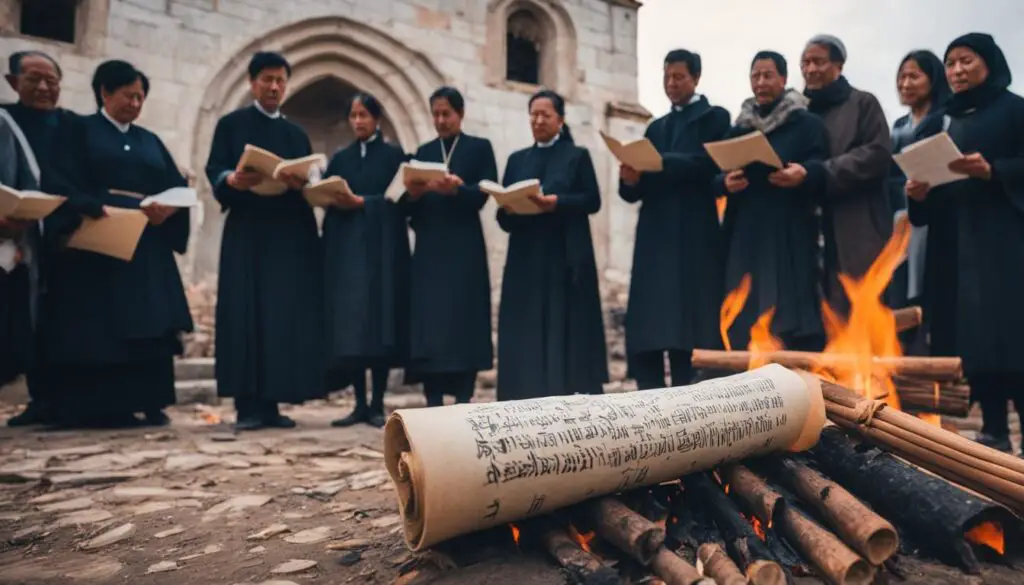
| Key Events | Significance |
|---|---|
| Early Christian Communities | Formation of the foundational beliefs and practices of the church. |
| Great Schism | Division of the church into Western (Roman Catholic) and Eastern (Eastern Orthodox) branches. |
| Protestant Reformation | Emergence of various Protestant denominations and the call for reform within the Catholic Church. |
| Enlightenment Period | Shift towards rationalism, scientific thinking, and challenges to religious authority. |
| Modern Era | Adaptation to societal changes, engagement in social justice movements, and embracing technological advancements. |
As we delve into the history and origins of the church, we gain a deeper understanding of its foundation, growth, and enduring impact on societies around the world. This knowledge allows us to appreciate the church’s contributions and be inspired by the faith-driven individuals who have shaped its story.
Beliefs and Doctrines of the Church
The church encompasses a rich tapestry of beliefs and doctrines that form the cornerstone of its teachings and principles. These fundamental tenets guide the congregation’s spiritual journey and provide a framework for understanding and cultivating faith.
At the heart of the church’s beliefs is a deep reverence for a higher power and the recognition of divine guidance in all aspects of life. The church teaches that through faith and adherence to its doctrines, individuals can experience profound spiritual transformation and a deeper connection to the divine.
“Our beliefs and doctrines serve as guiding beacons, illuminating the path of righteousness and leading us towards a life of purpose and spiritual fulfillment.”
In the words of Saint Augustine: “Faith is to believe what you do not see; the reward of this faith is to see what you believe.”
The church places great emphasis on the authority of sacred texts and views them as a source of divine revelation and spiritual wisdom. These texts, such as the Bible or the Quran, offer guidance on morality, ethics, and the nature of God, providing a solid foundation for a meaningful and transformative spiritual journey.

Furthermore, the church’s doctrines encompass a range of theological principles that guide its teachings and practices. These doctrines often include beliefs about the nature of God, the divinity of Jesus Christ, the role of the Holy Spirit, and the concept of salvation.
Through the study and contemplation of these core beliefs and doctrines, church members gain a profound understanding of their place in the world, their relationship with the divine, and their responsibilities as stewards of faith.
The Importance of Doctrinal Unity
Doctrinal unity within the church is vital for promoting a cohesive community of believers and fostering spiritual growth. It ensures that the teachings and interpretations of sacred texts align with the church’s core beliefs, providing consistency and a shared understanding of faith.
Table: Core Beliefs and Doctrines of the Church
| Beliefs | Doctrines |
|---|---|
| Belief in a higher power | Doctrine of the existence of God |
| Divinity of Jesus Christ | Doctrine of the Son’s divine nature |
| Role of the Holy Spirit | Doctrine of the Holy Spirit’s guidance |
| Salvation through faith | Doctrine of salvation by grace |
| Ethical and moral principles | Doctrine of ethical living |
These core beliefs and doctrines serve as a compass, steering the church community towards a life of righteousness, compassion, and spiritual transformation. They provide a solid foundation on which individuals can build their spiritual journeys and find solace, purpose, and hope in the embrace of the divine.
Sacraments and Rituals in the Church
The church comprises a rich tapestry of sacraments and rituals that hold profound spiritual significance for its members. These practices serve as tangible expressions of faith, fostering a sense of community, reinforcing beliefs, and forging a deep connection to the divine.
One of the most fundamental and widely observed sacraments in the church is the Holy Eucharist, also known as the Lord’s Supper or Communion. This sacred ritual involves the sharing of bread and wine, symbolizing the body and blood of Jesus Christ, respectively. Through this act, believers are reminded of the sacrificial love and redemption offered by Jesus.
“Take, eat; this is my body which is given for you. Drink from it, all of you; for this is my blood of the covenant, which is poured out for many for the forgiveness of sins.”
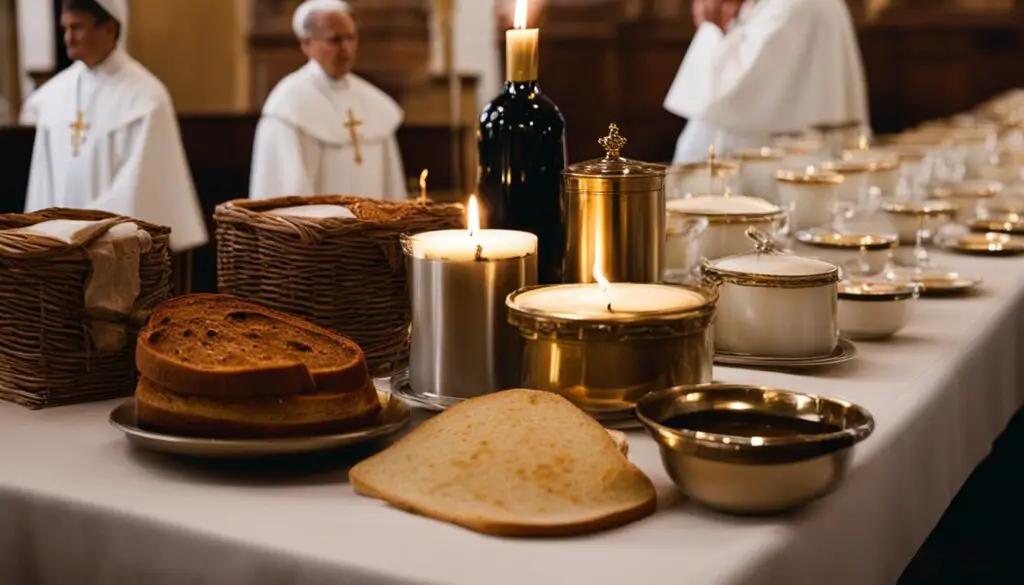
Another vital sacrament is Baptism, which signifies spiritual rebirth and initiation into the church community. It involves the symbolic act of immersion in water or the application of water to the forehead, representing purification, the washing away of sins, and the embrace of a new life in Christ.
The church also celebrates various rites of passage that mark significant milestones in a believer’s journey. These include confirmation, where individuals affirm their faith and receive the blessings of the Holy Spirit, and marriage, which sanctifies the union between two individuals and seeks God’s guidance and blessings on their lifelong commitment.
Furthermore, rituals such as worship services, prayer meetings, and religious ceremonies form an integral part of the church’s spiritual life. These practices enable congregants to come together, express their devotion, seek guidance, and experience a deeply personal connection with their faith.
Through sacraments and rituals, the church nurtures a sense of belonging, reinforces core beliefs, and allows individuals to experience the divine in a tangible and transformative way. These practices serve as pillars of strength, guiding the church community in their journey of faith and fostering a deeper understanding of God’s love and grace.
Leadership and Clergy in the Church
The church is guided by a dedicated group of individuals who provide leadership and spiritual guidance to the congregation. From pastors to deacons and church elders, these religious leaders play a vital role in nurturing the faith of their community.
Church leadership is characterized by a hierarchical structure that ensures smooth operations and effective decision-making. At the helm of the church, pastors serve as the primary spiritual leaders, responsible for preaching the word of God and shepherding the flock. With their knowledge and understanding of the scriptures, pastors offer guidance, support, and counsel to the congregation.
Deacons and church elders assist pastors in their duties and provide additional support to the church community. These individuals often serve as role models, embodying the values and teachings of the church through their actions and words. Their dedication and commitment contribute to the overall spiritual growth of the congregation.
In addition to their spiritual responsibilities, church leaders also oversee the day-to-day operations of the church. This includes planning and conducting worship services, organizing community outreach programs, and managing the church’s financial affairs.
“True religious leadership is not about power or control, but about servant-heartedness and humility.”
The leadership in the church recognizes the importance of fostering a sense of belonging and nurturing the spiritual well-being of the congregation. Through pastoral care, counseling, and active engagement, clergy members strive to create an inclusive and supportive community where individuals can grow in their faith.
By leading by example and upholding the values and teachings of the church, these religious leaders inspire and empower their congregation to live out their faith in their daily lives. Through their guidance, church leaders play a crucial role in shaping the spiritual journey of their community members and fostering a deeper connection with God.
| Key Roles and Responsibilities of Church Leadership: | |
|---|---|
| Pastors: | Provide spiritual guidance, preach sermons, and lead worship services. |
| Deacons: | Support pastors and assist in various church functions. |
| Church Elders: | Offer wisdom, mentorship, and oversight. |
| Administrative Duties: | Ensure smooth operations of the church, manage finances, and organize community initiatives. |
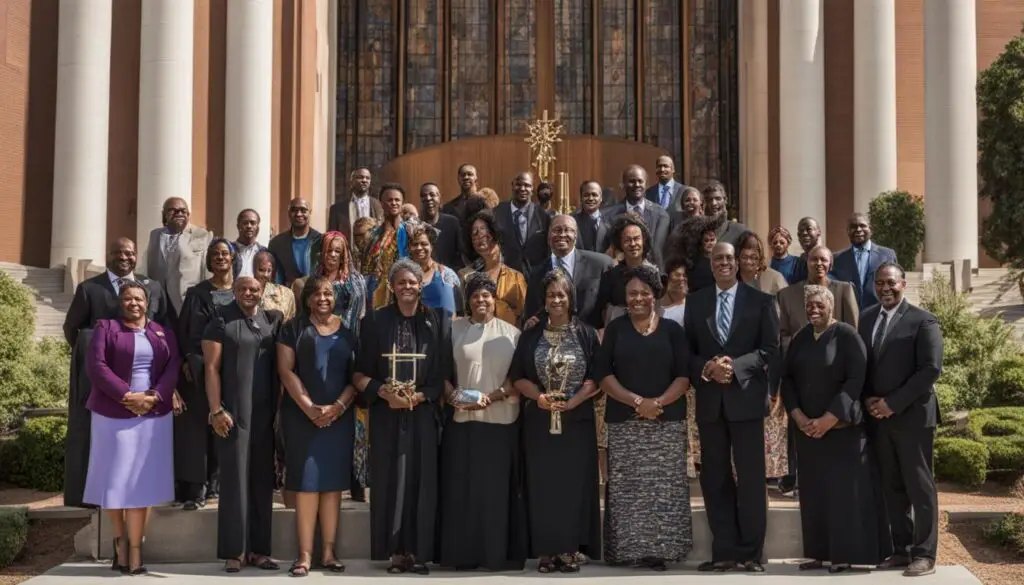
In the hierarchy of the church, leadership plays a vital role in creating a nurturing and supportive environment for the congregation. Through their guidance, church clergy and leaders inspire and encourage individuals to deepen their faith and embrace their role as part of a larger spiritual community.
Worship Practices in the Church
Worship is a sacred and transformative experience that lies at the heart of the church community. It encompasses a diverse range of practices aimed at connecting with the divine and expressing faith. Through prayer, singing hymns, reading sacred texts, and participating in communal rituals, congregants find solace, inspiration, and a sense of belonging in their spiritual journey.
Prayer: Prayers play a central role in worship services, allowing individuals to communicate with God, seek guidance, and express gratitude. They can be spoken, silent, or sung, offering a deeply personal and meaningful connection with the divine.
Singing Hymns: Music has a powerful way of touching the soul and is an integral part of worship services. Hymns are songs of praise and devotion that inspire congregants to join their voices together in harmony, lifting spirits and fostering a sense of unity.
Reading Sacred Texts: The reading and contemplation of sacred texts, such as the Bible, Quran, or Torah, holds immense significance in the worship practices of different religious traditions. These texts are a source of spiritual wisdom, providing guidance, inspiration, and a deeper understanding of faith.
Participating in Communal Rituals: Communal rituals, such as the Eucharist, baptism, and other sacraments, are vital components of worship services. These rituals symbolize spiritual rebirth, cleansing, and a deep connection with the divine. They serve as powerful reminders of the core beliefs and values of the church.
At the heart of worship services is the opportunity for congregants to come together, putting aside individual differences, and collectively express their devotion and faith. Through worship, individuals find solace, strength, and a profound connection to something greater than themselves.
Sacred Texts of the Church
The church places great importance on sacred texts, such as the Bible, Quran, or Torah, depending on the religious tradition. These texts serve as a source of inspiration, guidance, and spiritual wisdom for the church community.
The sacred texts, also known as religious scriptures, contain the foundational teachings and principles that shape the beliefs and practices of the church. As believers engage with these texts, they find solace, find answers to life’s questions, and deepen their understanding of their faith.
Church sacred texts are revered as divine revelations and are considered the ultimate authority on matters of faith and morality. They offer moral guidelines, ethical teachings, historical accounts, and spiritual truths that guide the beliefs and actions of the church’s followers.
“The Bible is not an end in itself, but a means to bring men to an intimate and satisfying knowledge of God, that they may enter into Him, that they may delight in His Presence, may taste and know the inner sweetness of the very God Himself in the core and center of their hearts.” – A.W. Tozer
These sacred texts are often studied through various methods such as exegesis, hermeneutics, and textual analysis to gain a deeper understanding of their meaning and relevance to contemporary life. They contain narratives, parables, laws, prophecies, prayers, and teachings that provide a comprehensive understanding of the divine and human experience.
Through the rich tapestry of sacred texts, the church community finds comfort, strength, and guidance in their spiritual journey. These texts serve as a compass, offering wisdom and insights that help believers navigate life’s challenges and cultivate a deeper connection with the divine.
The Bible: The Cornerstone of Christian Sacred Texts
For Christians, the Bible holds a special place as the foundational sacred text. Comprised of the Old Testament and the New Testament, the Bible contains the teachings, history, prophecies, and accounts central to the Christian faith.
The Old Testament encompasses the sacred writings of ancient Israel, including the books of Genesis, Exodus, Psalms, Proverbs, and many others. It contains historical records, laws, poetry, and prophecies that reveal God’s covenant with His people and provide insights into His character and plan for humanity.
The New Testament focuses on the life, teachings, death, and resurrection of Jesus Christ, as well as the early Christian community’s writings and teachings. It includes the four Gospels (Matthew, Mark, Luke, and John), the Acts of the Apostles, the Epistles (letters) of Paul and other apostles, and the Book of Revelation.
Through the reading and study of the Bible, Christians seek to understand the message of salvation, the nature of God, the life and teachings of Jesus, and the principles that govern their faith and conduct. The Bible serves as a guide for moral living, spiritual growth, and relationship with God and others.
While the Bible holds a central position in Christianity, other religious traditions also have their sacred texts. Muslims consider the Quran as the final and complete revelation of God to humanity, while Jews revere the Torah as the foundation of their faith.
These sacred texts are not mere historical documents but living and relevant sources of divine wisdom and guidance. They continue to inspire believers, shape religious practices, and provide a moral compass in an ever-changing world.

Denominations and Sects within the Church
The church is a diverse institution, encompassing various denominations and sects, each with its own unique set of beliefs, practices, and interpretations of sacred texts. These divisions within the church reflect the richness and complexity of religious traditions and the diverse ways in which faith is expressed.
Within the vast landscape of church denominations, each group has its distinct identity, organizational structure, and theological emphasis. Some well-known Christian denominations include Roman Catholicism, Eastern Orthodoxy, Anglicanism, Lutheranism, Presbyterianism, Baptist, Methodist, and Pentecostalism. These denominations have deep historical roots and have contributed significantly to the development and spread of Christianity throughout the world.
In addition to denominations, there are also various religious sects and factions that have emerged within specific branches of Christianity or other major religions. These sects often arise due to differing interpretations of scripture, disagreements on specific doctrines, or the pursuit of unique spiritual experiences.
Such sects and factions can take on a variety of forms, from more conservative and traditionalist groups to progressive and reformist movements. Some examples of religious sects within Christianity include the Amish, Quakers, Jehovah’s Witnesses, and the Mormon Church.
These divisions, though distinct, demonstrate the vibrant and ongoing dialogue within the church. It is through these differences that individuals and communities find their own spiritual paths and engage in meaningful discussions about faith, practice, and the interpretation of sacred texts.
“The diversity of denominations and sects within the church allows for a range of spiritual expressions and provides individuals with the opportunity to find a community that resonates with their beliefs and values.”
Variety of beliefs and practices
Denominations and sects within the church may vary in their beliefs and practices. While some may emphasize sacraments and rituals, others may prioritize personal piety and devotion. The interpretation of scriptures and the guidance of religious leaders often shape these distinctive characteristics.
| Denomination/Sect | Beliefs | Practices |
|---|---|---|
| Roman Catholicism | Belief in the authority of the Pope, Marian devotion, transubstantiation, purgatory | Mass, seven sacraments, praying the rosary |
| Protestantism | Emphasis on faith alone for salvation, authority of scripture, justification by grace | Biblical preaching, baptism, Lord’s Supper (Communion) |
| Eastern Orthodoxy | Importance of the Holy Tradition, veneration of icons, theosis (union with God) | Liturgy, iconography, orthodox prayers and fasting |
| Mormonism | Additional revelation through the Book of Mormon, belief in eternal progression and exaltation | Baptism for the dead, temple rituals, family values |
Note: The above table provides a brief overview and is not exhaustive. Beliefs and practices may vary within each denomination and sect.
Community and Outreach in the Church
The church is more than just a place of worship. It is a vibrant community that plays a significant role in the lives of its members and the surrounding neighborhoods. Through various outreach initiatives, the church extends its mission of love, compassion, and service beyond its walls, making a positive impact on society.
Inspired by their faith, church members come together to foster a sense of belonging and support within the community. This spirit of community creates an environment where individuals can find solace, build relationships, and grow together in their spiritual journey.
One of the core pillars of the church’s community is its commitment to charitable activities. This includes organizing events, fundraisers, and campaigns to raise funds and resources for those in need. From providing food and shelter to the homeless, offering assistance to low-income families, or supporting disaster relief efforts, the church community strives to alleviate suffering and promote justice and equality.
“Serving others is not just a duty, but it is an expression of the love that we have received from God. It is an opportunity to make a difference in someone’s life, to bring hope where there is despair, and to be the hands and feet of Jesus in the world.” – Pastor Sarah Thompson
Community service projects are another way the church engages with the community. These initiatives range from organizing clean-up days in local parks, volunteering at community centers, or partnering with nonprofit organizations to address specific needs in the area. By actively participating in community service, the church demonstrates its commitment to making a positive impact and improving the quality of life for all.
Examples of Church Outreach Programs:
| Program | Description |
|---|---|
| Food Pantry | A weekly program providing groceries to families facing food insecurity. |
| Homeless Shelter | A temporary shelter offering a safe space, meals, and support services to those experiencing homelessness. |
| Medical Outreach | A free health clinic providing basic medical care, check-ups, and referrals to uninsured individuals. |
| Children’s Mentoring | A mentorship program pairing volunteers with at-risk children to provide guidance, support, and positive role models. |
These outreach programs not only address immediate needs but also aim to establish long-term relationships built on trust and mutual respect. Through its dedicated efforts, the church strives to be a source of hope, healing, and inspiration for the broader community.
Architectural and Artistic Features of the Church
The architecture and artistic features of churches are a testament to the grandeur and spirituality of these sacred spaces. With their intricate designs and awe-inspiring structures, churches beautifully blend art, symbolism, and religious devotion. From soaring spires that reach towards the heavens to meticulously crafted stained glass windows, these architectural elements serve as gateways to the divine, captivating the senses and inspiring contemplation.
One of the most notable features of church architecture is the use of towering spires. These vertical structures, often reaching great heights, symbolize the aspiration to connect with the divine realm. They point skyward, beckoning the faithful to look beyond the material world and seek a higher spiritual truth.
Another remarkable aspect of church design is the intricate detailing found in the facades and interiors. From ornate carvings depicting religious narratives to delicate stonework showcasing intricate patterns, these artistic elements reflect the devotion and craftsmanship of those who built them. Each detail serves a purpose, telling a story or conveying a deeper symbolic meaning.
Stained glass windows, with their vivid colors and delicate craftsmanship, are an iconic feature of church artwork. These windows are not just decorative; they serve as visual representations of the faith and its teachings. They depict religious stories, saints, and biblical scenes, bathing the interior spaces in vibrant hues and casting ethereal light that adds to the overall ambiance.
When stepping into a church, you are often greeted by the mesmerizing sound of pipe organs. These intricate musical instruments have long been associated with sacred spaces, providing a powerful and resonant voice during worship services. The majestic tones of the organ create a sense of awe and elevate the spiritual experience.
Symbols and Their Significance
In addition to the architectural elements, churches are adorned with various symbols that hold deep meaning within the religious context. These symbols serve as visual representations of faith and belief, providing a spiritual language that transcends words.
“The symbols in churches serve as a visual vocabulary, speaking volumes about the beliefs and traditions upheld by the congregation.”
The cross, perhaps the most universally recognized symbol, represents the crucifixion of Jesus Christ and serves as a powerful reminder of sacrifice, redemption, and eternal life. It stands as a focal point within the church, towering above the altar and reminding worshippers of the core tenets of the faith.
The dove is a symbol of the Holy Spirit, representing peace, purity, and divine presence. Often depicted in stained glass windows or as sculptures, the dove serves as a visual reminder of the spiritual guidance and comfort that is believed to be bestowed upon believers.
The lamb, often depicted with a halo, symbolizes Jesus Christ as the sacrificial Lamb of God. It represents innocence, obedience, and the ultimate act of love and atonement for humanity’s sins.
The image of an open Bible signifies the importance of scripture in the church. It symbolizes the teachings and wisdom contained within the sacred texts and serves as an invitation to explore and delve deeper into the word of God.
These are just a few examples of the many symbols found within churches, each carrying its own significance and contributing to the overall spiritual experience.
The Beauty of Church Artwork
Church artwork encompasses a wide range of mediums, from paintings and sculptures to intricate tapestries and mosaics. These pieces of art serve as visual expressions of faith, bringing to life the stories and teachings of the religion.
“Church artwork seeks to engage the senses, evoke emotions, and inspire a deeper connection with the divine.”
The use of vibrant colors, meticulous brushwork, and attention to detail in paintings and frescoes create a visual feast for the eyes, engaging worshippers and drawing them into the narratives portrayed. They depict biblical scenes, saints, and religious figures, inviting contemplation and reflection.
Sculptures within churches capture moments of devotion, sacrifice, and triumph, giving physical form to abstract concepts and making them relatable and tangible. These three-dimensional works of art are often carved from stone, wood, or metal, showcasing the skill and dedication of the artists.
Tapestries and mosaics found in churches are intricately crafted, using an array of materials to create stunning visual representations. These textile art forms and decorative compositions serve to enhance the ambiance of the church, adding layers of beauty and depth to the sacred spaces.
| Artistic Feature | Description |
|---|---|
| Stained Glass Windows | Vividly colored glass pieces arranged in intricate designs, depicting religious stories and figures. |
| Altar Paintings | Larger paintings that adorn the altar area, often depicting religious scenes or significant figures. |
| Sculptures and Statues | Three-dimensional representations of religious figures, often carved from stone or wood. |
| Tapestries | Textile artworks woven with intricate patterns and designs, often depicting biblical scenes or religious symbolism. |
| Mosaics | Artwork made by arranging small colored pieces of glass or stone into intricate patterns and designs. |
Contemporary Issues and Challenges Facing the Church
The church today encounters various modern challenges and issues that require careful consideration and adaptation. As society evolves, the church grapples with navigating changing societal norms, addressing social justice concerns, and managing controversies within the religious community.
One of the significant challenges for the church is the need to adapt to changing societal norms while staying true to its core beliefs. In an increasingly diverse and inclusive world, the church faces the task of embracing and welcoming individuals from different backgrounds and lifestyles. Balancing traditional teachings with a compassionate and accepting approach can be a delicate path to tread.
The church must embrace and welcome individuals from different backgrounds and lifestyles, while staying true to its core beliefs.
Social justice concerns play a crucial role in contemporary church issues. The church is called to actively engage in addressing issues such as poverty, inequality, racism, and environmental stewardship. By advocating for justice and actively working towards positive change, the church can fulfill its mission of love and service to others.
Navigating controversies within the religious community is another challenge the church faces. Different interpretations of sacred texts, theological differences, and debates on moral and ethical issues can create tensions within the church. Finding common ground and fostering respectful dialogue and understanding is essential to maintaining unity and a sense of community.
Ultimately, the church must remain relevant by responding to the needs of its members and society as a whole. Adapting to societal changes, addressing social justice concerns, and managing controversies are all part of the church’s ongoing journey to fulfill its mission in a complex and ever-changing world.
Contemporary Challenges Facing the Church
| Challenge | Description |
|---|---|
| Adapting to Changing Societal Norms | The need to reconcile traditional teachings with evolving societal values and attitudes. |
| Social Justice Concerns | Engaging in issues such as poverty, inequality, racism, and environmental stewardship. |
| Managing Controversies | Navigating disagreements and tensions within the religious community. |
Embarking on Your Church Establishment Journey
Starting a church is a transformative and fulfilling journey. It requires careful planning, dedication, and adherence to core principles. As you embark on this path, it is essential to have a clear vision for your church’s growth and impact. By implementing effective church growth strategies, you can establish a strong foundation that will foster spiritual growth and create a thriving community.
One of the key strategies for starting a church is to build a strong sense of community. Encourage active participation and create opportunities for believers to connect with one another. Foster an environment that promotes love, support, and a shared sense of purpose. By nurturing a sense of belonging, you can help individuals develop a deeper faith and commitment to the church.
Establishing a strong foundation also involves aligning your church with a set of core beliefs and doctrines. Clearly articulate your beliefs and ensure they are firmly grounded in Biblical principles. This will guide your teachings, shape your congregation’s spirituality, and set the direction for your church’s mission. By staying true to your beliefs, you can attract individuals who resonate with your message and create a strong spiritual foundation.
The journey of starting a church is not without its challenges. However, it is through these challenges that growth and learning occur. Embrace them as opportunities to refine your vision, strengthen your leadership, and adapt to changing needs. By navigating these obstacles with resilience and faith, you can build a church that remains relevant and impactful in the modern world.
FAQ
What are the key strategies for starting a church establishment?
Starting a church involves starting with a small discussion group, turning that group into a launch team, legally establishing the church, considering affiliation with a network or denomination, and growing through excellence in love.
What is the history and origins of the church?
The church has deep roots in ancient times and has evolved over centuries. It has been influenced by historical events such as the separation of church and state and has played a crucial role in preserving church history and traditions.
What are the core beliefs and doctrines of the church?
The church has a set of core beliefs and doctrines that shape its teachings and guide its congregation. These beliefs serve as the foundation for understanding spirituality and faith.
What are the sacraments and rituals in the church?
The church has various sacraments and rituals that hold spiritual significance. These practices foster a sense of community, reinforce beliefs, and provide a connection to the divine.
What is the leadership structure in the church?
The church has a hierarchical structure of leadership that includes pastors, deacons, church elders, and other clergy members. These leaders provide guidance, lead worship services, and oversee church operations.
What are the worship practices in the church?
Worship is an integral part of the church experience and involves practices such as prayer, singing hymns, reading sacred texts, and participating in communal rituals. Worship services provide opportunities for congregants to connect with the divine and express their faith.
What are the sacred texts of the church?
The church places great importance on sacred texts such as the Bible, Quran, or Torah, depending on the religious tradition. These texts serve as sources of inspiration, guidance, and spiritual wisdom for the church community.
What denominations and sects exist within the church?
The church is composed of various denominations and sects, each with its distinctive beliefs, practices, and interpretations of sacred texts. These divisions reflect the diversity of religious beliefs and traditions within the church.
How does the church contribute to the community?
The church fosters a sense of belonging, promotes charitable activities, and provides support to those in need. Through community outreach programs, the church extends its mission beyond its walls and makes a positive impact on society.
What is the significance of the architectural and artistic features of the church?
The architecture and artistic features of churches are awe-inspiring and rich in symbolism. These elements reflect the spiritual and cultural heritage of the church.
What are the contemporary issues and challenges facing the church?
The church faces challenges such as adapting to changing societal norms, addressing social justice concerns, and navigating controversies within the religious community. These challenges require the church to remain relevant while staying true to its core beliefs.
How can I embark on my church establishment journey?
Starting a church is a transformative and fulfilling journey that requires careful planning, dedication, and adherence to core principles. By following growth strategies, establishing a strong foundation, and nurturing a sense of community, you can create a thriving spiritual home for yourself and others.





